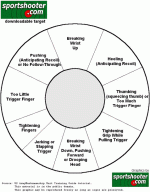Hello All, and thanks in advance for your advice!
I've been shooting poorly many decades, and reloading for a few years, but this problem seems to be ME and I can't seem to overcome it!
At ten yards with my GP100 shooting .38 specials offhand, I can consistently group about tennis ball size, which I don't consider too bad for an old guy with bad rotator cuffs and tennis elbow, not to mention the other things...
HOWEVER with my Glock 45acp, Rohrbaugh R9, Springfield 45acp, Glock 40, and if I load .357's in the GP, I'm all over the board! I know I MUST be flinching or something. I say "all over" but most bad shots seem to be low left. I know it's not the guns, 'cause if I sandbag rest, they all shoot excellent.
I've tried dry-firing in the house with just primers in an empty cartridge, and realized I'm anticipating the recoil and tightening up. I thought I got over that.... Any advice/practice drills would be helpful.
Thanks for your time,
Steve W.
I've been shooting poorly many decades, and reloading for a few years, but this problem seems to be ME and I can't seem to overcome it!
At ten yards with my GP100 shooting .38 specials offhand, I can consistently group about tennis ball size, which I don't consider too bad for an old guy with bad rotator cuffs and tennis elbow, not to mention the other things...
HOWEVER with my Glock 45acp, Rohrbaugh R9, Springfield 45acp, Glock 40, and if I load .357's in the GP, I'm all over the board! I know I MUST be flinching or something. I say "all over" but most bad shots seem to be low left. I know it's not the guns, 'cause if I sandbag rest, they all shoot excellent.
I've tried dry-firing in the house with just primers in an empty cartridge, and realized I'm anticipating the recoil and tightening up. I thought I got over that.... Any advice/practice drills would be helpful.
Thanks for your time,
Steve W.

